How do we attain and hold onto happiness? Although this question has been the implied or overt subject of countless self-help books, it has no neat or simple answers. The stories in Virginia Pye’s compelling new collection, Shelf Life of Happiness, acknowledge this reality in fresh and perceptive ways. And they allow us to witness transformational moments in the lives of characters who are seeking out happiness or life satisfaction, or struggling with its elusiveness.
In “Best Man,” the central character, Keith, travels to Reno to be part of the wedding of his closest friend, Don, and Don’s girlfriend and caretaker, Caroline. Don has needed Caroline’s help because he is suffering from AIDS and has become quite frail. (The story appears to be set in the 1980s, when virtually nothing could be done to alter this disease’s deadly course.)
For Keith, the Reno experience couldn’t be more fraught, and not only because his dear friend is dying. He’s confused about why Don has entered a relationship with a woman after “getting into the whole gay scene out in California.” And Keith finds that he’s attracted to Caroline, a beauty who is “exactly his type.”
In the hours after the wedding—while Keith, Don, and Caroline ride out a snowstorm in a shared hotel room—Keith has to face these feelings, and confront a truth about himself. He reflects that, unlike Don, who allowed himself to become vulnerable in the face of love and infatuation, Keith
In a surprising and intimate (but ultimately chaste) encounter, Caroline gets Keith to lay open his heart “in all its confusion” to her and Don. Afterward, lying alongside Caroline and Don, Keith reflects on his heightened connection with both of them:
Although Keith’s feelings might not constitute happiness, exactly, they suggest that he’s reached a new level of awareness about himself and his friends, and that he’s been changed forever by the Reno experience. Pye captures this transformation with deep feeling.
“White Dog,” which brings together a rising-star gallery owner and an aging artist whose career he might revive, explores the differences between these two men’s notions of what constitutes a satisfying life. To the gallery owner, Rob, happiness seems inseparable from career success and notoriety. To the artist, Dunster, the most rewarding and sustaining thing has always been his work.
Although these notions of happiness should be able to coexist, possibly in mutually beneficial ways, a deeper conflict between the men seems destined to dash any potential for a lasting relationship. Pye portrays this conflict masterfully, moving between the points of view of Dunster and Rob, who has invited Dunster to his country house to get to know him better. Although the two men rarely oppose each other openly, their private thoughts and observations almost always are in counter-step.
Take, for instance, Rob’s thoughts about the grounds surrounding his home (he, Dunster, Rob’s wife, and Dunster’s granddaughter have gathered there to socialize):
Now, here’s Dunster’s take on the grounds:
Tensions heighten when a sickly white dog appears on the property, much to Rob’s annoyance. (When the animal appeared earlier, he’d fired a gun to try to scare it away.) To Rob, the dog is defiling his ideal landscape. But Dunster sees the pitiful creature–and all imperfections–as part of the territory of real life, which can never be ideal.
I don’t want to reveal what happens with the dog, but it informs one of Dunster’s final observations in the story: “The only way to live was to absorb the mess and the blight and the decay, embrace every imperfection into both life and art.” Through passages like this, the story offers a fascinating study of the men’s starkly opposing perspectives on life and art, and suggests the larger significance of these views.
(As an aside, “White Dog,” like “Redbone,” a later story in the collection, is great at capturing the tensions between art-as-business, subject to the whims and wiles of market forces and tastemakers, and art as something deeply personal to its creators, offering an almost—or actual—spiritual experience and an unparalleled way of connecting with the world. Pye offers telling insights into these tensions.)
The title story, “Shelf Life of Happiness,” turns to matters of love. It focuses on the ongoing connection between a young man, Nathan, and his college crush, Gloria, with whom he works at a publishing company. Complicating matters is the fact that Nathan and Gloria are married to other people. Furthermore, Gloria has begun making passes at Nathan that he doesn’t exactly discourage, though he seems to have a mutually loving relationship with his wife, Melissa.
While Nathan, Melissa, Gloria, and Gloria’s husband are out together, Gloria makes this comment:
A moment later, Gloria says, “Nathan understands what I mean. … As a writer, he grasps the need to reinvent ourselves.”
As the story progresses, and as Gloria steps up her seduction of Nathan, these comments raise an intriguing question: Does happiness, or at least avoiding becoming “colossally dull,” require pursuing what’s fresh and exciting–even if this is destructive? (In this case, Gloria’s and Nathan’s marriages stand to be destroyed.)
Through his encounters with Gloria, Nathan is forced to figure out what happiness would entail for him. As he begins to, his ruminations get at a larger truth: that happiness can come from what rewards us in lower-key ways–gradually, through daily experiences and efforts–often, beneath our notice. His marriage to Melissa seems to offer such lower-key rewards.
As a whole, the stories in “Shelf Life of Happiness” acknowledge that efforts to find happiness or life satisfaction are rarely free of trials, missteps, or mistakes. That doesn’t mean that they aren’t worth pursuing, and that they can’t yield rewards, at least some of the time.
Would My Pick be Your Pick?
If you're interested in ________, the answer may be "Yes":▪ Explorations of what constitutes a happy or rewarding life
▪ Stories about art: both the business of it and creative concerns






